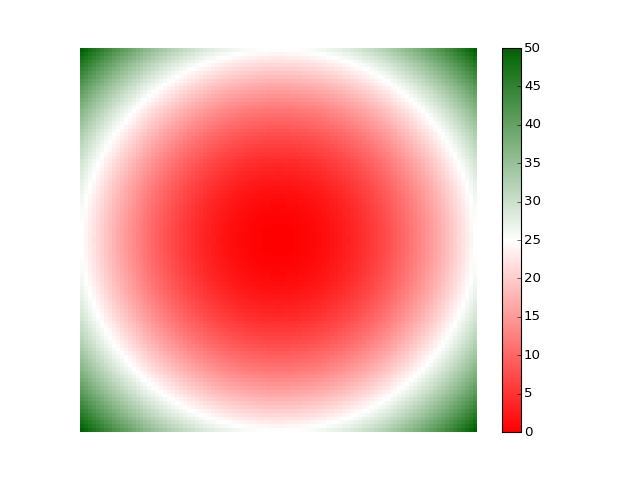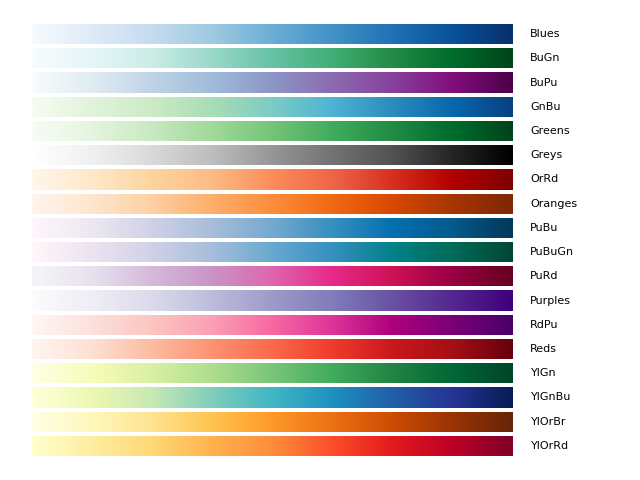1. Conventions¶
1.1. hexadecimal¶
hexadecimal can be encoded as explained in colormap.colors.hex2rgb():
- #FFF
- #0000FF
- 0x0000FF
- 0xFA1
1.2. normalisation¶
By default, input should be normalised (e.g., RGB values between 0 and 1) and outputs are normalised. If you provide unnormalised values (e.g., RGB in 0-255) then set the noramlised parameter to True (see example in codecs).
2. Codecs¶
2.1. list¶
There is a bunch of codecs available in colormap.colors such as hex2rgb:
>>> from colormap.colors import hex2rgb
>>> hex2rgb("#FFF", normalise=False)
(255, 255, 255)
>>> hex2rgb("#FFFFFF", normalise=True)
(1.0, 1.0, 1.0)
| codecs | |
|---|---|
| hex2web | colormap.colors.hex2web() |
| web2hex | colormap.colors.web2hex() |
| hex2rgb | colormap.colors.hex2rgb() |
| rgb2hex | colormap.colors.rgb2hex() |
| rgb2hls | colormap.colors.rgb2hls() |
| rgb2hsv | colormap.colors.rgb2hsv() |
| hsv2rgb | colormap.colors.hsv2rgb() |
| hls2rgb | colormap.colors.hls2rgb() |
| hex2dec | colormap.colors.hex2dec() |
| yuv2rgb | colormap.colors.yuv2rgb() |
| rgb2yuv_int | colormap.colors.rgb2yuv_int() |
| yuv2rgb_int | colormap.colors.yuv2rgb_int() |
2.2. format¶
- RGB (red/green/blue): a triple of values between 0 and 255
- HLS (): H in 0-360 and L,S in 0-100
- HSV (): H in 0-360, S,V in
- YUV: all in 0-1
3. Color class¶
On task, which is quite common is to know the hexadecimal code of a color known by name (e.g. red). The colormap.colors.Color would be useful:
>>> c = Color('red')
>>> c.rgb
(1.0, 0.0, 0.0)
>>> c.hls
(0.0, 0.5, 1.0)
>>> c.hex
'#FF0000'
>>> print(c)
Color Red
hexa code: #FF0000
RGB code: (1.0, 0.0, 0.0)
RGB code (un-normalised): [255.0, 0.0, 0.0]
HSV code: (0.0, 1.0, 1.0)
HSV code: (un-normalised) 0.0 100.0 100.0
HLS code: (0.0, 0.5, 1.0)
HLS code: (un-normalised) 0.0 50.0 100.0
Input when instanciating can be anything in RGB, HEX, HLS, common name from colormap.xfree86:
>>> sorted(colormap.xfree86.XFree86_colors.keys())
4. colormap¶
There are lots of colormap in matplotlib. This is great but some may be missing or it is not obvious to know what the colormap will look like.
The colormap.colors.Colormap class allows you #. to build easily new colormaps and visualise them #. visualise existing colormaps
4.1. visualise colormaps¶
>>> from colormap import Colormap
>>> c = Colormap()
>>> c.plot_colormap('sequentials')
(Source code, png, hires.png, pdf)
Try with other sets:
- sequentials2,
- misc
- diverging
- qualitative
4.2. Create a linear colormap¶
The simplest colormap are linear with 3 colors. In such case, we provide a method that is easy to use. Imagine you want a colormap from red to green with white color in between:
c = Colormap()
cmap = cmap_linear('red', 'white', 'green')
c.test_colormap(cmap)
Here, we use color names, which are the xfree86 names. However, you could have used any format accepted by Colors:
red = Color('red')
cmap = cmap_linear(red, 'white', '#0000FF')
4.3. Create a general colormap¶
In the previous example, we used 3 colors assuming a linear scale. However, you may want a different scale, in which case, you need to provide more colors. In such case, you can use cmap() method.
Here we again use the same example a above but it can be generalised easily. First, we need to know the RGB components of the colors:
>>> from colormap import Color, Colormap
>>> green = Color('Dark Green').rgb
>>> red = Color('red').rgb
>>> white = Color('white').rgb
>>> white
(1.0, 1.0, 1.0)
For instance RGB values of white are 1,1,1
Second, built a dictionary with the three RGB name (red/green/blue) as keys and with the values being the evolution of the red/green/blue when a value goes from 0 to 1. Here, we use a linear scaling so we just need 3 values at 0, 0.5, and 1. Therefore we have list of 3 values. You could provide list of arbitrary lengths if required
>>> c = Colormap()
>>> mycmap = c.cmap( {'red':[1,1,0], 'green':[0,1,.39], 'blue':[0,1,0]})
Finally, test it:
c.test_colormap(mycmap)
(Source code, png, hires.png, pdf)

